
OBJECTIVE: The player with the highest score at the end of the fifth round wins
NUMBER OF PLAYERS: 3 – 8 players
MATERIALS: 105 card deck, 5 reference cards, 1 thank you recipe card, instructions
TYPE OF GAME: Hand shedding & climbing card game
AUDIENCE: Ages 8+
OVERVIEW OF REIGN OF DRAGONESS

Grandpa Beck is known for taking classic card games and adding a wonderful theme and new elements of gameplay. Reign of Dragoness is a hand shedding and climbing game related to the classic Big Two. In this game, players are trying to be the first to empty their hand of cards. This is done by playing different types of patterns in ascending rank to a pile. If a player cannot (or chooses not to) play, they may pass which could help save powerful cards for later.
WHAT’S IN THE BOX

The one hundred card deck includes eight different suits. Each suit contains twelve dragon cards numbered 1 – 12. Suits are ranked low to high: Lochen, Frond, Cyklone, Aetherie, Safyre, Ridge, Merc, and Gylden. A card’s suit rank is denoted by how many jewels are located below its number. Nine special cards have powers to help the player on their turn. Five reference cards are included as well. As with all of Grandpa Beck’s games, a thematic recipe card is in the box for players to make and enjoy.
SETUP FOR REIGN OF DRAGONESS

The deck is constructed based on how many players are in the game. A 2-4 player game uses five suits as well as one Dragoness, page, squire, Dragon knight, and revive. Five players require an additional suit and revive. Seven suits, two pages, and two revives are needed for a six player game. For a 7-8 player game, all of the suits and special cards are required.
Shuffle and deal thirteen cards to each player. Any undealt cards are placed to the side. Place the reference cards so each player is able to see them.
THE PLAY
Whoever has the lowest ranking card in their hand goes first. The dealer should begin by asking who has the lochen 1, then the frond 1 and so on until the lowest card is identified. That player goes first, and they play a pattern (which includes that card) to the table.
There are three types of patterns in this game: a single, a set, and a run. A single is just one card. Sets are made up of two to five cards of the same number. Runs are three to five cards in numbered sequence.
Once the first player has placed their pattern (including that lowest card) on the table, the turn passes clockwise. The next person must follow the pattern exactly. This means they must play the same number of cards and the pattern-type. If a pair of two cards is played, a pair must also be played by the next player. Also, the next pair played must be STRONGER. At least one card in the next player’s pair needs to be stronger than the one previously played (a higher number, or a stronger suit of the same number).
Any player who cannot play a stronger pattern to the table, or any player who does not want to play their cards, may pass. Once a player passes, they may not rejoin play until the pile is completed or a revive card is played.
A pile will continue to grow until everyone has passed. The last person to play a pattern to the pile wins that challenge and begins the next pile with a pattern of their choice.
SPECIAL CARDS
Dragoness is the most powerful card in the deck with a rank of 13. She can be played as the most powerful single or as part of a run. It is not possible to play her in a set. A revive card cannot be used to reset the pile if a Dragoness has been played.
Dragon Knight is a wild card used to represent any number needed in the gylden suit. When played as a single, he is always a 12.
Page cards are wild and can represent any number 1 – 8. They are part of the lochen suit. Squires are wild cards that represent any number 9 – 12 in the lochen suit. Both pages and squires count as 8’s and 9’s respectively if played as singles.
Revive cards allow a player to reset the pile. After playing a revive card, the same player immediately plays a matching pattern of a lower value than the one previously played. A revive card cannot be played on top of the Dragoness, a 12, or the Dragon Knight when played as a 12.
WINNING REIGN OF DRAGONESS
The round ends once a player has emptied their hand. If a player has nothing but revive cards remaining in their hand, their hand is considered empty. Whoever empties their hand first wins the round and earns three points. Two points are awarded to the player with the next fewest cards, and one point awarded to the player with the third fewest cards.
If there is a tie for second place, each player in the tie gets two points and no third place points are awarded. A tie for third place means all tied players get one point.
Whoever has the most points at the end of the fifth round wins the game.
- TRIPLE SNAKES - February 15, 2021